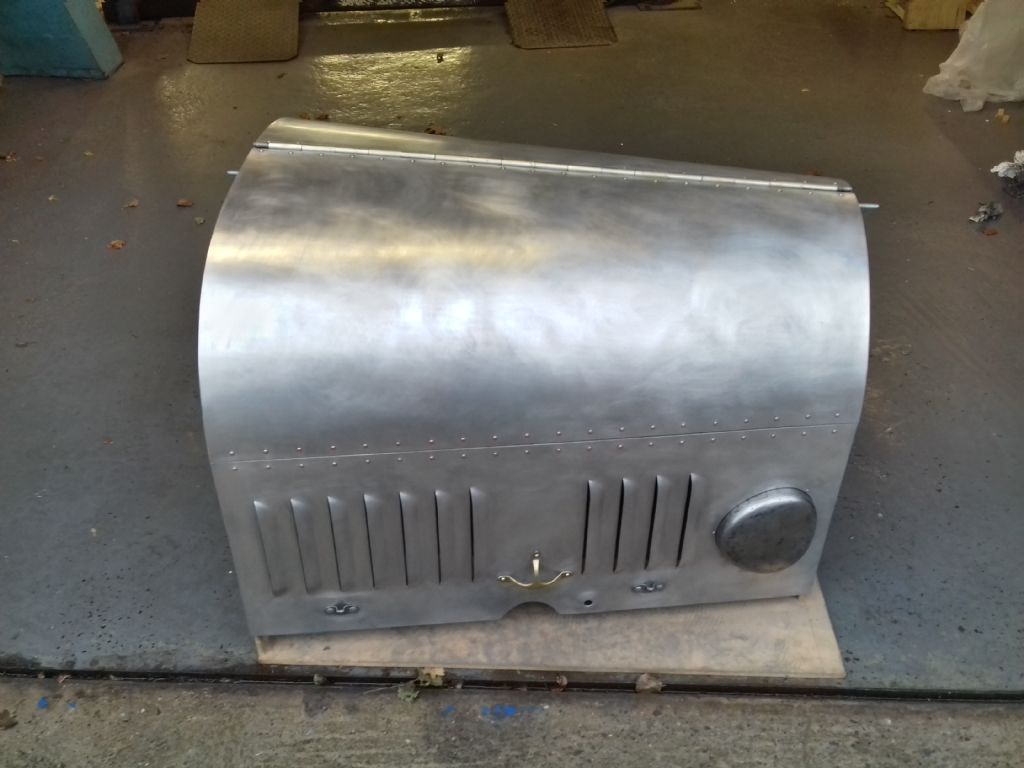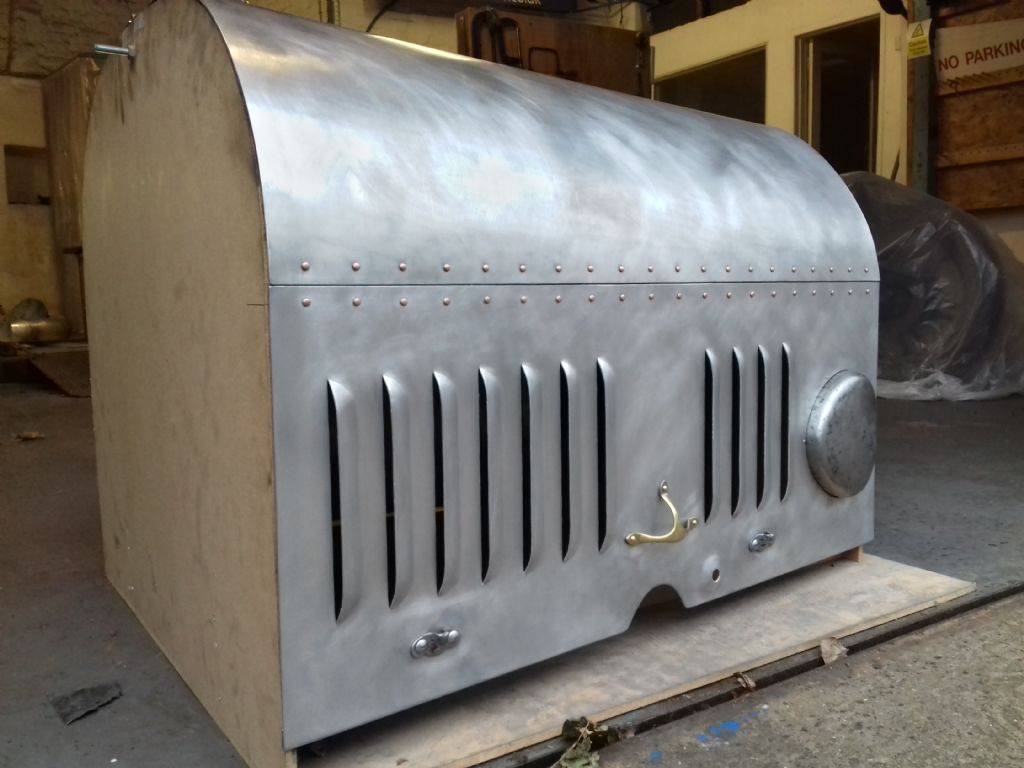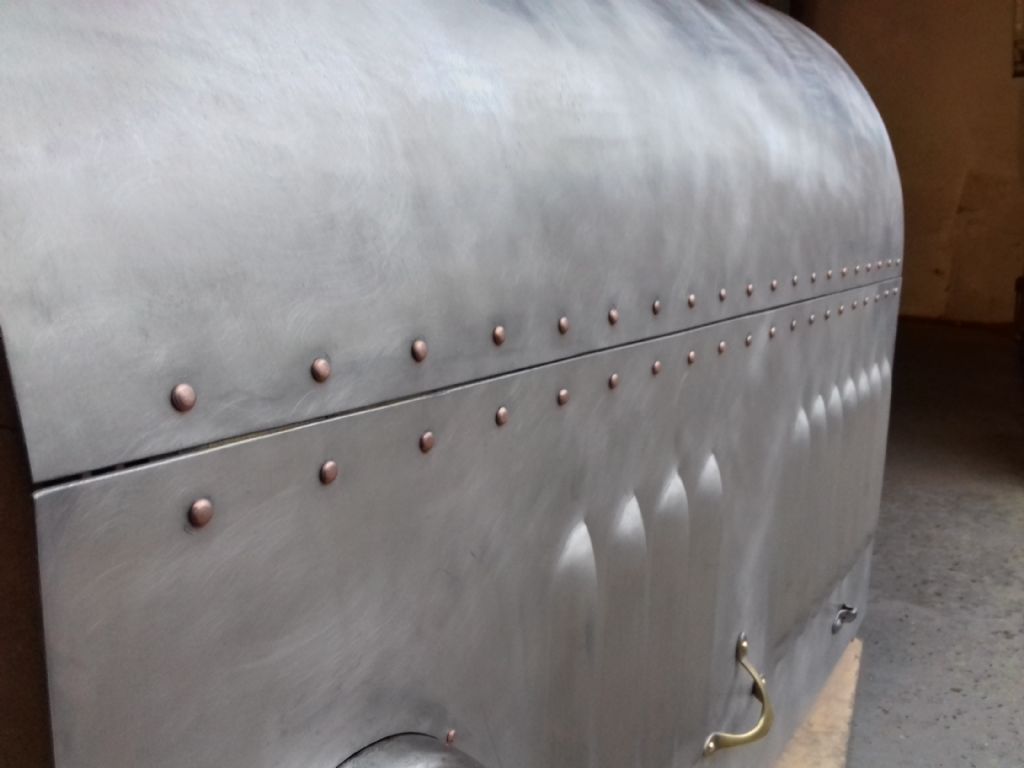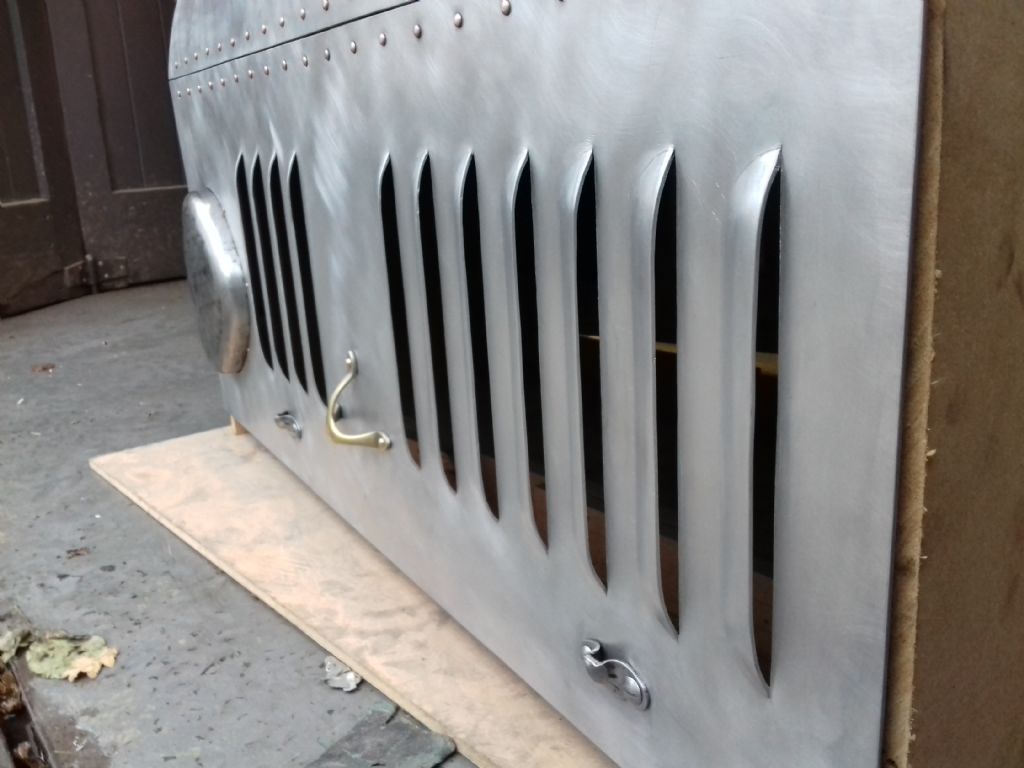Copper Solid Rivets
| Stirring Moose | 29/07/2018 15:16:10 |
| 31 forum posts 5 photos | Not a specific question this time, more an appeal for any info anyone deems relevant and is willing to share. I am in the process of making up a new bonnet for a vintage car. The panels are aluminium, most of the fittings (hinges, handles etc.) are brass. On the original item which I have been asked to copy, all the bits are held together using copper solid rivets. I have done plenty of pop riveting in my time but this is a new departure for me, thus I am on the hunt for all the info I can grab. The vastness of the internet will of course be trawled directly, but in the mean time any hints on suppliers (of both rivets and tooling), useful instructional links, copper specs to look out for, machining up my own rivets if it comes to it and generally how to not make a t*t of oneself when riveting would be most gratefully received. Many thanks, S.M. Edited By Stirring Moose on 29/07/2018 15:17:00 |
| Brian H | 29/07/2018 15:22:08 |
2312 forum posts 112 photos | Hello S.M. Many of the medel engineer suppliers with be able to supply copper rivets and the tools. Are the rivets domed on one side? What size shank (if known, otherwise it can be worked out from the head diameter)? Roughly, where are you?, it may be that one of us can help with the rivets and the tools. How many rivets do you need? Brian |
| Stirring Moose | 29/07/2018 15:33:49 |
| 31 forum posts 5 photos | Brian, Many thanks for the quick response. To deal with the questions in order: Some of the rivets are domed and I think that would have been the original spec. Hopefully having a chat with the client sometime this week to see which way we're going on that one. At least two different sizes in use. Again, will be getting into details this week. Am based in Crediton, near Exeter in Devon. Number of rivets? Again that's TBC but wouldn't be surprised if we're knocking on the door of a hundred once done. S.M. |
| Speedy Builder5 | 29/07/2018 16:15:38 |
| 2878 forum posts 248 photos | Search Riveting on this site - there are at least 9 different threads for you to have a read of. |
| Clive Brown 1 | 29/07/2018 16:36:55 |
| 1050 forum posts 56 photos | Are the original panels aluminium? For aluminium boat equipment, eg aluminium masts etc. copper rivets and brass fittings would be an absolute no-no for corrosion reasons. Might be less of a problem with a car perhaps, especially if well painted, but aluminium rivets should be readily available if you so decided, and possibly easier to set. Clive. Edited By Clive Brown 1 on 29/07/2018 16:37:40 |
| Stirring Moose | 29/07/2018 16:42:27 |
| 31 forum posts 5 photos | Posted by Speedy Builder5 on 29/07/2018 16:15:38:
Search Riveting on this site - there are at least 9 different threads for you to have a read of. Have already been nosing about on here as part of my own research. Some interesting bits and bobs but a lot of it a bit too "job specific". I'm really starting from scratch with the basics I'm afraid. S.M. |
| Stirring Moose | 29/07/2018 16:45:56 |
| 31 forum posts 5 photos | Posted by Clive Brown 1 on 29/07/2018 16:36:55:
Are the original panels aluminium? For aluminium boat equipment, eg aluminium masts etc. copper rivets and brass fittings would be an absolute no-no for corrosion reasons. Might be less of a problem with a car perhaps, especially if well painted, but aluminium rivets should be readily available if you so decided, and possibly easier to set. Clive. Edited By Clive Brown 1 on 29/07/2018 16:37:40 Aluminium panels, brass fittings, copper rivets. That appears to be how they did it "back in the day" and we're trying to stay as faithful to the original as possible. S.M. |
| Mike E. | 29/07/2018 17:03:58 |
217 forum posts 24 photos | Google "riveting aircraft panels". |
| clogs | 29/07/2018 17:23:05 |
| 630 forum posts 12 photos | HI, I use a lot of brake lining rivets for body work, various lengths and dia's........ for specials I make my own........
|
| Sherlock | 04/08/2018 02:29:04 |
| 52 forum posts 11 photos | I actually researched this a while back.. Here are a couple of the best resources I found. Hope they are of help to you.
|
| Nimble | 04/08/2018 23:47:38 |
66 forum posts 6 photos | Hi Stirring Moose, Some time ago I was searching for hollow brass rivets for the cone clutch on my car, and came across the follows sites. Hope they may help you with your search, wwwchicagorivet.com, and Regards, Nimble Neil
|
| Tim Stevens | 06/08/2018 17:20:12 |
1779 forum posts 1 photos | A colleague has a Railton (1930s) with a long aluminium bonnet, and as you say, copper rivets for the hinges. He has had trouble with corrosion, and recently got a professional respray job done. He still has problems with corrosion. It may be that with a polished alloy finish rather than paint there is less chance for the corrosion to get a firm grip, but I have no confidence about that. Sorry. Good strong aluminium rivets are available, - they are used to hold aeroplanes together. Cheers, Tim |
| Stirring Moose | 07/08/2018 22:28:37 |
| 31 forum posts 5 photos | Lots of interesting info coming up here - thanks everyone. Interesting that the bimetallic corrosion issue keeps popping up. I've long been aware the problem between aluminium and steel but can't say I've come across it so much between aluminium and copper. Certainly no sign of problems when I removed the old copper rivets from the original aluminium panels to release the hinges and other fittings for re-use. Another interesting point is that a friend of mine who used to tend historic racing Aston Martins told me it was common practice to use copper grease to stop, or at least reduce, the corrosion where the aluminium body met the steel chassis/floor pan - a known rot spot on old Astons. Admittedly his is the only reference I have heard to the practice; anyone else encountered it? S.M. |
| Sherlock | 07/08/2018 23:29:42 |
| 52 forum posts 11 photos | Here is a good explanation said much better than I could.
Let's start by looking at a single metal unconnected to any other metal. It is made of atoms that have positively charged nucleuses (okay, "nuclei", Miss Crabapple) which are surrounded by electrons which balance the charges, and all is well. Then let's say these atoms become exposed to a corrosive media (an electron stealer). The corrosive media steals an electron. Now that atom is no longer an atom, but a positively charged ion in search of an electron; so it dissolves into the media in search of an electron to balance it. So, what actually causes corrosion is the loss of electrons from the metal. Metals are electrically conductive, i.e., electrons can run through them from one spot to another just as they run through a wire. So if two different metals are mechanically connected in any fashion at all without an electrical insulator between them, electrons can run through them. Now take a chunk of two different metals connected together and expose them to a corrosive media which is stealing electrons. The way galvanic protection/corrosion occurs is: when the nobler metal (the copper in this case) has an electron stolen from it by the corrosive solution, it has a greater affinity for electrons than the baser metal and immediately steals back an electron from the baser metal (aluminum in this case). The result is that the copper atom remains a balanced atom of metal, and the aluminum atom comes up short and corrodes into solution. |
| Tim Stevens | 08/08/2018 14:55:33 |
1779 forum posts 1 photos | I'm sure Miss Crabapple would have had a funny turn at the use of media in the single, too ... Cheers, Tim |
| Stirring Moose | 13/11/2018 19:51:12 |
| 31 forum posts 5 photos | Apologies for not finishing this tale before now. Below are some pictures of the completed bonnet, complete with copper rivets. Thanks to all those on here who chipped in with bits of info For those of an automotive bent, the vehicle for which the bonnet is ultimately destined is a 1924/28 3/4.5 litre Bentley. S.M. |
| Brian H | 13/11/2018 20:46:10 |
2312 forum posts 112 photos | Beautiful! Brian |
| FMES | 13/11/2018 21:35:37 |
| 608 forum posts 2 photos | If they are going to be painted over I would suggest Monel metal rivits. Regards Edited By FMES on 13/11/2018 21:35:49 |
| Ian S C | 14/11/2018 09:58:04 |
7468 forum posts 230 photos | No, aluminium is the way to go. Brass, copper, and aluminium, this could be a way of powering the next generation of electric cars Ian S C |
| KWIL | 14/11/2018 11:06:01 |
| 3681 forum posts 70 photos | At least when the corrosion does start, observers will be able to note that the restoration was entirely authentic, complete with the dreaded corrosion of old!! |
Please login to post a reply.
Want the latest issue of Model Engineer or Model Engineers' Workshop? Use our magazine locator links to find your nearest stockist!
Sign up to our newsletter and get a free digital issue.
You can unsubscribe at anytime. View our privacy policy at www.mortons.co.uk/privacy
- *Oct 2023: FORUM MIGRATION TIMELINE*
05/10/2023 07:57:11 - Making ER11 collet chuck
05/10/2023 07:56:24 - What did you do today? 2023
05/10/2023 07:25:01 - Orrery
05/10/2023 06:00:41 - Wera hand-tools
05/10/2023 05:47:07 - New member
05/10/2023 04:40:11 - Problems with external pot on at1 vfd
05/10/2023 00:06:32 - Drain plug
04/10/2023 23:36:17 - digi phase converter for 10 machines.....
04/10/2023 23:13:48 - Winter Storage Of Locomotives
04/10/2023 21:02:11 - More Latest Posts...
- View All Topics
- Reeves** - Rebuilt Royal Scot by Martin Evans
by John Broughton
£300.00 - BRITANNIA 5" GAUGE James Perrier
by Jon Seabright 1
£2,500.00 - Drill Grinder - for restoration
by Nigel Graham 2
£0.00 - WARCO WM18 MILLING MACHINE
by Alex Chudley
£1,200.00 - MYFORD SUPER 7 LATHE
by Alex Chudley
£2,000.00 - More "For Sale" Ads...
- D1-3 backplate
by Michael Horley
Price Not Specified - fixed steady for a Colchester bantam mark1 800
by George Jervis
Price Not Specified - lbsc pansy
by JACK SIDEBOTHAM
Price Not Specified - Pratt Burnerd multifit chuck key.
by Tim Riome
Price Not Specified - BANDSAW BLADE WELDER
by HUGH
Price Not Specified - More "Wanted" Ads...
Do you want to contact the Model Engineer and Model Engineers' Workshop team?
You can contact us by phone, mail or email about the magazines including becoming a contributor, submitting reader's letters or making queries about articles. You can also get in touch about this website, advertising or other general issues.
Click THIS LINK for full contact details.
For subscription issues please see THIS LINK.
Model Engineer Magazine
- Percival Marshall
- M.E. History
- LittleLEC
- M.E. Clock
ME Workshop
- An Adcock
- & Shipley
- Horizontal
- Mill
Subscribe Now
- Great savings
- Delivered to your door
Pre-order your copy!
- Delivered to your doorstep!
- Free UK delivery!















 Register
Register Log-in
Log-in


